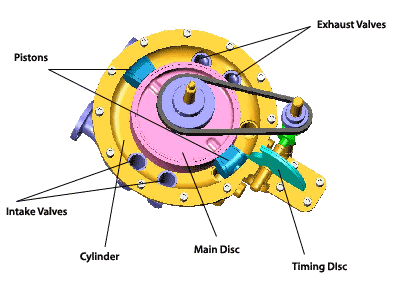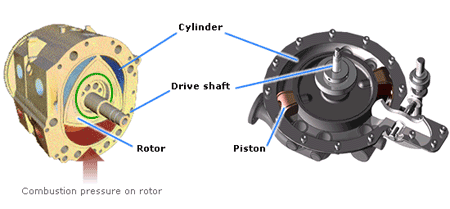I’ve stumbled upon this new way of making combustion engines called Round Engine, or it’s more techy-sounding name Variable Geometry Toroidal (VGT).

At first I thought it’s some kind of rotary engine but it’s not. I will talk about how it’s different later.
VGT Technologies Inc likens their VGT engine to a pushing merry go round, while normal engines are paddling bicycles.
Key aspects of the VGT Engine
- Circular piston housing where the piston goes in circles instead of a straight housing where the piston goes up and down.
- Crankshaft and conrods are replaced by a main disc which connects to the driveshaft.
- Pistons are connected directly to the main disc. In a normal engine this means it’s connected directly to the drive shaft. The shape of the piston is unique, and has to interface with the timing disc to complete the cylinder.
- The timing disc functions as the top of the cylinder.
- Round Engine has only one compression and exhaust chamber. Air intake and exhaust valves are shown on the diagram. Variable valve positioning can be achieved with a slot and some mechanism to move the slot cover to create moving valves.
- Combustion occurs outside piston housing in a separate chamber. This means only one spark plug is required. On larger engines, a second combustion chamber can be added directly opposite (180 degrees) the first combustion chamber.
How does it work?
Basically air is compressed by the rotating piston using the timing disc surface as the top of the cylinder. The air is compressed between the piston and the timing disc.
After that, air is moved to the combustion chamber by the piston. The valve closes and compressed air is trapped in the combustion chamber. Fuel is injected, spark ignited and combustion occurs.
The combusted air pushes the piston forward until the piston travels past the exhaust valves. The gas is then exhausted through the exhaust valves once the piston moves past the exhaust valves.
Basically for each rotation of the drive shaft, two combustions will occur because the Round Engine has two pistons.
Differences between the rotary engine and the Round Engine.

The rotary (Wankel) engine is elliptical while the Round Engine is perfectly round. The two engines also use different torque arms. Because of the shape, a rotary engine’s torque arm continually varies similiar to a normal piston engine. But with the Round Engine, the torque arm follows a perfect circular path so the torque arm is always constant.
Other benefits of the Round Engine design include smoothenss because the circular motion generates virtually no vibrations. Limited amount of moving parts also increases engine life. The design is also modular, allowing multiple Round Engines to connect to the same drive shaft.
Before this blog post gets too long, you can check out more about the Round Engine at VGT Technologies Inc.
Looking to sell your car? Sell it with Carro.


new engine….. wah……. now which 1 is better now?
rotary or round?…….
and paul , what car use this engine?
Which company that got this tech, some independant research company or what??? They got some hint about specialists from Uni of Calgary though… I've checked out the stats, seems like damn powerful with better emission also… but think it wont be in mass production for some time though…
Btw, wonder how many people team developed this, and how come some people could develop an altogether new technology but we just cant get the damn campro engine to work with existing technology(VVTI/VTEC)???
displacement on demand? wow! soon we can bring in foreign cars and declare them as 99cc lawn movers to avoid paying AP fees. :)
round engine, this is not new..have been use as airplane engine for sometime now
round engine?!? i guess the creative engineering teams' brain is round too~ >.
I wonder how the Japanese pronounce "Wankel". I mean, they have trouble replacing L's with R's…
8287: propeller engines for aeroplanes are rotary, and the jet turbines are well… jet turbines. are you sure they're using this round engines?
and if its "really" used in airplane, i'm pretty sure its a different concept. imagine the size of an airplane's engine, placed in a car! gotta shrink a lot there! i fink, its a totally different concept, the round engine and the rotary engine used in airplanes.
anyway, how bout the things like power comparisons and stuff, any?
which company/team research this? anymore infos on them? and will it be implied into consumer vehicles anytime soon? or… just for fun? haha~
yes Paul, try this link http://www.acroflyer.com/Turbine_round.htm
Those round engines are rotaries… not the same as this one.
http://www.aviation-history.com/engines/rotary-th…
Paul,thanks you for your correction
i don't think with all of the creative talent producing new versions of internal combustion engines, like the ecoforce, the revetec, the Round Engine, the CEM and others, why do they all seem to run out of steam when they start looking for investors and markets? (Technically, the CEM isn’t quite there yet) Is there some big conspiracy going on keeping all of these little guys down? Is there too much “not invented here†thinking going on? I don’t think so, it’s likely more straight forward than that. I believe all of these engineers and designers are simply too late. They’re building new variations of the internal combustion engine as everyone is trying to find an alternative to it. Companies aren’t looking for more efficient ways to burn gasoline, they want to stop burning gasoline. They can improve the engines they already have, when it comes time to invest major capital in retooling, they want to build the next engine beyond gasoline.What are your comment..
SWEET!!! This engine seems to have a higher potential for gobs of horsepower, like the rotaries! I think mainly due to the pistons which seems to have very small mass (f=ma) and little friction (since it moves in a circular motion, instead of up-and-down), and if mounted horizontally, does not have to fight gravity.
One question though – how is this engine lubricated? It seems like a possible problem.
should be the same way as rotaries are lubricated
Maybe they using impregnation lubrication, but if like that ah, the piston ring will not as durable as normal engine, doesn't it
What about quasiturbine engine?
Check this link..
http://auto.howstuffworks.com/quasiturbine.htm
Good article, I also wonder how does this compare against a quasiturbine.
You must both read and UNDERSTAND what the article says about how this engine works. You also have to have AT LEAST some understanding of how Wankel engines, quasi-turbines, and airplane engines work to make any kind of reasonable comparison. The comparisons I’ve seen here in the comments so far show NO understanding.
An airplane engine uses reciprocating pistons. That is, they go back and forth in a straight line instead of traveling in the same direction around a circle. Huge difference there. The only thing circular in the old plane engines is that the cylinders are placed in a circle around the crankshaft, each one in line with a radius from the center of the circle. Nothing to do with this design.
The quasi-turbine and Wankel are both rotary engines and do not move in a circle. They are elliptical or quasi-elliptical. All three of these are more complex with more parts and more vibration because the moving parts do not move in a circle around a center, which in the case of the RoundEngine is the crankshaft. Anything non-circular introduces an element of reciprocation or back and forth motion and cause greater wear as well as vibrations. I have a background in electronics and physics, but have no practical experience with automobile engines. However, I can read and UNDERSTAND technical descriptions. It really helps. Seriously. Try it.
Check out Albert Harvey Rotary Engines and my Email
Check out Albert Harvey Rotary Engines and my Email